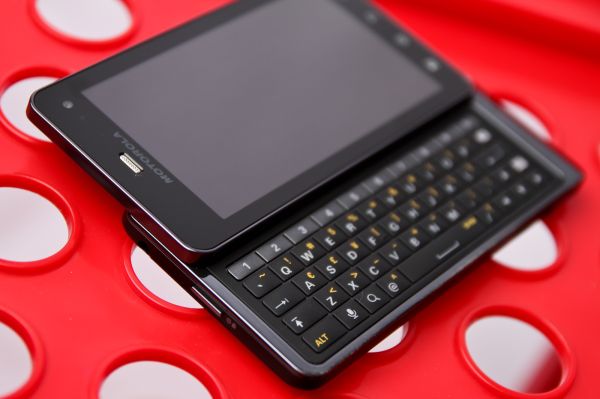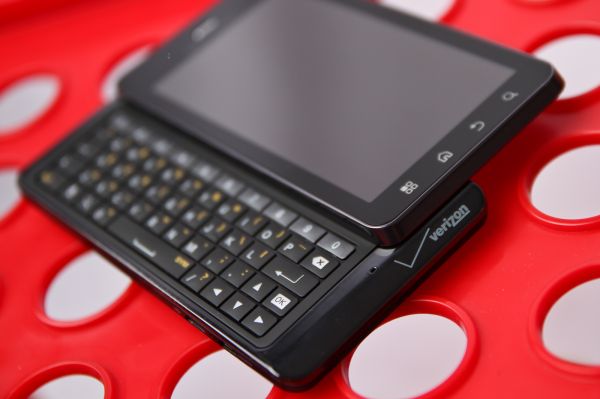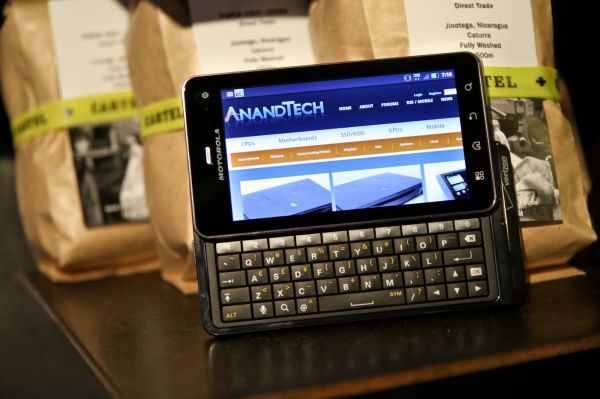Motorola Droid 3 Review - Third Time's a Charm
by Brian Klug on July 30, 2011 12:01 AM ESTConcluding Thoughts
So here we are, one year after the Droid 2, and now we have the Droid 3. Dual core smartphones are now pretty much the norm, and overall smartphone adoption shows little to no signs of slowing down anytime soon. On its own, the Droid 3 is a considerable upgrade over the Droid 2. You get a vastly better keyboard, higher resolution display, better cameras, higher resolution and better quality video recording, much better CPU and GPU performance, a better baseband with GSM/WCDMA compatibility out of the box, and Android 2.3.4. One short year later, the same price buys you a considerably better device in almost every possible category.
The problem is that there’s no LTE onboard, which seems in retrospect like a major tactical error on Motorola’s part until you consider that adding that in would likely dramatically change the Droid 3’s size and battery life. Like it or not, we’re still in the first generation of LTE modems, all of which are 45nm at present. Qualcomm’s LTE MDM9600 baseband, which is at the core of an overwhelming majority of current Verizon Wireless LTE devices, is a 45nm part and not directly voice enabled. Around mid 2012, MDM9615 will begin shipping, bringing 28nm LTE/EVDO/DC-HSPA+ connectivity in a slightly smaller, less power-hungry package, and also bringing onboard voice to bear. Only at that point (or with MSM8960 potentially sooner) and with similar parts does LTE connectivity on the device become something you can include without a complicated dual-baseband solution.
It’s roundabout, but basically what looks at first like a tactical error on Motorola’s part really isn’t - they made a design tradeoff and instead the Droid 3 is one of the thinnest (if not the thinnest) devices with a slide-out keyboard. Instead, if you want LTE and a physical keyboard, you’re going to have to wait a while until Samsung or another partner brings it to bear. That said, Motorola does have some LTE-enabled devices headed to Verizon, which we’ll look at in due time, but they likely won’t include keyboards.
If you’re in a market that Verizon hasn’t included in its official list for deployment by the end of 2011, there’s really no point to owning a first generation LTE smartphone. At that point, current devices like the Droid X2 or Droid 3 make sense, or waiting for devices based on some less power-hungry second generation basebands that will no doubt be the rage around the same time next year.
I like the Droid 3 a lot more than I thought I would going into it, just because of how much importance I personally put on having the fastest cellular connectivity. It’s sort of a running joke among friends and people that know me that I spend far too much time running speed tests, and so I went into this review ready to be underwhelmed by more EVDO slowness. I was definitely wrong about how great this device really turned out to be. Keyboard, display, OMAP4, and overall size culminate to a device that feels like way more than just an updated Droid 2.
The device has had another unintended side-effect as well. The Droid 3’s awesome keyboard has made me wish more of the Android flagship, triple-A devices had physical keyboards. Capacitive multitouch keyboards are great, but something is always going to get lost in the process of making a keyboard virtual. It’s also clear to me that developer focus has shifted away from landscape view, with so many Android applications forcing you into portrait-only mode because there’s so much more attention on portrait than landscape devices with keyboards. Maybe it’s time for a Nexus device with a keyboard to remind developers that landscape still exists.













84 Comments
View All Comments
jigglywiggly - Saturday, July 30, 2011 - link
i'd sell myselfThis phone lux nice, do want, I just wish it was on at&T
7amood - Saturday, July 30, 2011 - link
why don't I see any galaxy s2 in the comparison charts and where is the galaxy s2 review from anandtech?? :/ *waiting*Brian Klug - Saturday, July 30, 2011 - link
We actually just got an SGS2 in this week (international version) and I'm busily working on the review for that device ;)-Brian
Omega215D - Saturday, July 30, 2011 - link
I got to spend some time with this phone and it is pretty nice but doesn't feel as solid as the Original Droid nor look as elegant. Thankfully the Droid 3 got it where it counts performance-wise. The phone crashed when activating the camera and required a battery pull but that was only once. If I didn't have my Thunderbolt (which is doing well on battery life now) the choices would be Droid Incredible 2 or Droid 3 as they are both international phone. That would change if Verizon decides to get more WP7 phones.I liked the review. It's very detailed and unbiased, unlike the sorry excuse for a review from PhoneArena which shows it's clear Apple bias.
Johnmcl7 - Saturday, July 30, 2011 - link
I'm extremely disappointed there's not even one phone of this class and type for sale here, there's rumours of an HTC Doubleshot with a keyboard but still no sign of it. I've been trying the software keyboard on a Tab for a while but I can't stand it, I much prefer the N900's physical keyboard which leaves me stuck for the moment for an upgrade.John
Brian Klug - Sunday, July 31, 2011 - link
I guess you could always spring for the Chinese version, but hopefully there's a Milestone international version equivalent coming soon.-Brian
piroroadkill - Saturday, July 30, 2011 - link
Aw man, even my Desire HD has 768, and it actually gets put to use.Why cheap out, Motorola?
That said, as much as this looks great, I'd never recommend it due to Motorola's anti-modding community stance. Oh well.
Ben - Saturday, July 30, 2011 - link
I'm wondering if "The Droid 3 has excellent ambient noise cancellation during calls, again thanks to the two extra antennas which are no doubt used for processing. I’m not sure what IP is beyond the Droid 3’s noise rejection hardware, but clearly it does a good job."Should read as "The Droid 3 has excellent ambient noise cancellation during calls, again thanks to the two extra microphones which are no doubt used for processing. I’m not sure what IP is behind the Droid 3’s noise rejection hardware, but clearly it does a good job."
Brian Klug - Saturday, July 30, 2011 - link
Yeah I got antennas and microphones sort of confused there, thanks! Fixed now!-Brian
Bob-o - Saturday, July 30, 2011 - link
It's awesome they included a row of numbers at the top, I hate switching when entering mixed input. But why, oh why did they not put the usual secondary symbols on the number keys??! You know, !, @, #, $, etc. That's standard!!! What were they thinking??! Groan. . .Also:
> What feels neglected is how anemic the hardware keyboard auto-replace engine is.
> Compared with the gingerbread and even Motorola multi-touch keyboards, the hardware
> keyboard has an almost non-existant auto-replace engine for fixing misspelled words.
This makes me question Android's software stack. Why would each device (whether physical or virtual) have to implement this functionality? This should be a filter on input, no matter what device the user is using to enter data. . . and so it should work identically no matter what keyboard is being used. Stupid.